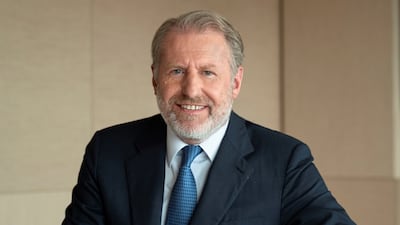Guillaume de Seynes and I sit on a train speeding its way back towards Paris. De Seynes has just cut the ribbon at the opening of his family-owned company Hermes’s 24th artisanal workshop in France.
“We are sustainable by essence,” he explains. “My grandfather, Robert Dumas, was once asked for his definition of luxury. And he said a luxury object is one that you can repair. It says everything.”
The new leather workshop in L’Isle-d’Espagnac in south-west France, has been built to sustainability gold standards. On the site of a former airfield, the 5,800-square-metre building was designed by Bordeaux firm Guiraud-Manenc using largely local materials: Charente stone cladding, poplar and red cedar framing, earth and straw insulation. A planted roof and 1,800 square metres of solar panels top it off.

It signals Hermes's commitment to Made in France and will eventually house 260 artisans producing small leather goods, as well as Birkin and Kelly bags. “We’ve now reached a more industrial size, with more than 7,000 people involved in making leather goods,” says de Seynes.
Yet, scale hasn’t changed the maison’s backbone: savoir-faire. “We keep the artisanal ways of making things. We stick to the size of the workshops, and don’t go over 300 people, because beyond that it’s not the same family spirit.”
Today’s workshops are open-plan, light-filled spaces where mostly women craft each bag from start to finish. “One man, one bag. It’s now more one woman, one bag, but when I was a child, it was only men.”

Despite the modern aspect of the facility, de Seynes resists any innovation in the production process. “We still believe each piece is made by one person, because this is where the artisanal aspect resides. If not, people would be doing handles or finishing edges all day long. We have decided once and forever we won’t go in that direction.”
That decision lengthens the infamous waiting lists, but also preserves desirability. “Scarcity is not a policy or goal for us. It’s a result of being dedicated to maintaining the highest level of quality. Each bag has a personal mark, so every bag is identifiable.”
Sometimes those marks reappear decades later. “We have stories of artisans now in repair, repairing one of their own bags. Once, my cousin Axel [Dumas, executive chairman] was giving a speech when a woman showed a rare violet crocodile bag to an artisan. The artisan said: ‘I think I made your bag.’ And everybody was crying. My cousin was making his speech, and nobody was listening, because they were all with these two ladies,” he says.

This commitment is formalised through L’Ecole Hermes des savoir-faire, founded in 2021. The 18-month training course, recognised by the French Ministry of Education, ends with a CAP diploma.
“For the first six months, students learn the basic gesture of leatherwork, and in the second are learning a specific model, generally the Kelly bag. For the final six months, they are in the workshop to learn and really catch the exact quality requirements. After 12 months, they have a permanent job.”
Young people are drawn to the promise of long-term careers. “In Paris or Lyon, you’ll find people with 35 or 40 years in the company,” he says.

Walking through the new site, the calm is striking: the smell of wax, the quiet rhythm of tapping hammers, personalised workstations. Quality requirements are strict, but artisans manage their own days.
Hermes’s expansion comes as the luxury sector faces criticism over price hikes and alleged declining quality. But de Seynes is unshaken. “The whole philosophy – that we have continued to transmit and respect generation after generation, even as the size of the company has completely changed – is always the same. First, the obsession for quality; quality of the materials and quality of the know-how.
“Second is freedom of creation. Not marketing, but true creation. Nobody in this company has the title ‘director of marketing’. It doesn’t exist. When we propose our objects, we try to offer the best possible quality. And this has a cost. My grandfather used to say: ‘Hermes objects are not expensive, they are costly.’ And this means a lot. It means that we never set a marketing price [the maximum price a market will tolerate]. We just look at our costs and we add a nice margin. This approach is very deep in our culture.”

Prices reflect hours of work and premium materials. A Kelly bag, for example, uses 36 pieces of leather. One calf skin may yield only two perfect panels. Offcuts are turned into wallets or whimsical objects for the Petit H line. “The best possible leather, the best possible metallic parts, finished by hand, 16 to 18 hours of artisanal work – I think customers know there is a real value to the product,” he says.
Resale values seem to prove him right: Hermes bags consistently outperform rivals at auction. But de Seynes cares more about integrity in production. This pursuit of perfection extends beyond leather. “Hermes has never been about just saving money. For example, we use beautiful cashmere from Nepal, because of the specific way of weaving which is very different from Italy or France, and gives a different personality. It’s not because it’s less expensive.”

Supplier relationships are similarly scrutinised. “We keep things close. We try to have long-term relationships. Some have been with us for 80 years. In silk, I’m working with someone whose father worked with my uncle, and his grandfather with my grandfather. As long as the quality is there, we continue.” Wrongdoing, however, ends partnerships instantly. “We stop immediately. There is no second chance.”
As one of the few remaining family-run fashion houses in an industry of conglomerates, Hermes benefits from continuity at the top. “In the executive committee, we have three cousins. We are really close, and we’ve been raised in the same spirit,” says de Seynes. It is little wonder the spirit of excellence has been intact since 1837.



FOLLOW TN MAGAZINE